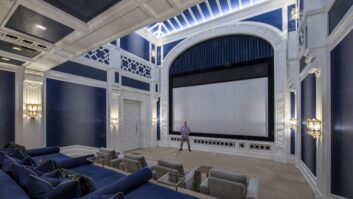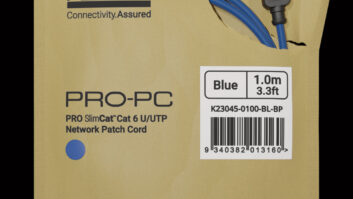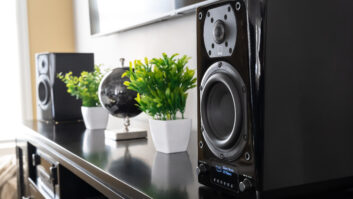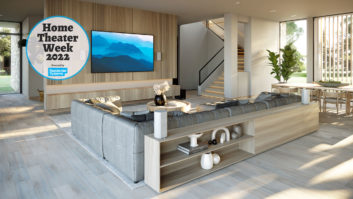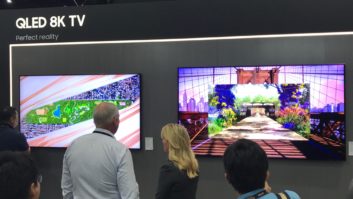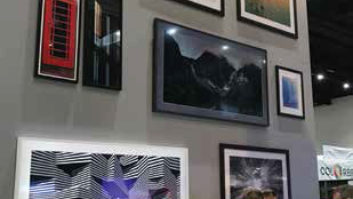
Paradigm’s Monitor Series SUB, SUB 10, and SUB 12 offer a compact footprint with
a 300W RMS amplifier and advanced DSP.There’s nothing quite like the bone jarring, thumping, thick molasses pulsation of sub-30Hz low-frequency sound. And apparently, more consumers are looking to swim in the sea of subsonic sound waves. For custom installers, the forecast is just peachy for subwoofer sales, with bass lovers proliferating and product development leading the way to more–and more in-depth–installs.
The most widely permeating inclination for the low frequency category is increasingly smaller form factors, along with in-wall options delivering high caliber sound like never before. This aspect alone has led to a multitude of opportunities for integrators to sell more subs in more installations, as well as more subs in the same room.
“I think that the current state of the subwoofer market is the best it’s ever been,” said Brian Azzano, sales manager for Stealth Acoustics. “I think that the amount of innovative products on the market today is at an all-time high and that there are new products on the horizon that will help to revolutionize the way we use subwoofers in and around the home.”
New technologies in particular are credited for the market growth, according to SpeakerCraft president Keith Marshall. He specifically cited the expansion of Class D and other high-efficiency power amplifier technologies, “[making] it possible to deliver hundreds of watts of power from a small, affordable amplifier that runs cool. When you combine this big increase in power with the development of extremely high-excursion small woofers, it becomes possible to get impressive bass output from a small enclosure.”

Leon Speaker’s O-Hawk sub is a variation on the Aaros Ultra-Thin, providing a sculptural rendition built to be a statement piece.There’s also no shortage of competitors in the market. But there are other means for dynamic rivalry too. “The chasm that exists between entrylevel and high-end products continues to widen,” noted Mark Weisenberg, brand marketing manager, Sunfire, “creating a new competitive environment within this category. As with everything CE, consumers are demanding more features for less money, driving prices lower and putting challenges on integrators and retailers to generate profits.”
Sunfire developed its Stillbass, anti-vibration technology as a result, which allows for high performance in-wall subwoofers like the HRSIW8, as well as the SubRosa on-wall system.
Pretty much every subwoofer manufacturer offers a smaller and/or in-wall solution today, and has for some time, but the benefits of doing so have expanded beyond the heard-but-not-seen demand from homeowners. With a smaller subwoofer, “You can better control the low frequencies in a room by using multiple subs,” said Kary Wawrzyniak, vice president of technology, TruAudio. “Two or more subs are recommended for best performance to eliminate bass dead zones and phase cancellations. With the multi-sub install, the integrator will have a larger bottom line and be able to provide a better home theater experience.”

Phase Technology has three models available in its PC-SUB-WL series of wireless subs, but any powered sub can be turned into a wireless unit via a wireless sub receiver, which works in tandem with Phase Technology’s WL-Surround system.The design trend for more audio systems today is based more closely on a professional cinema, as Paul Hales, founder, Pro Audio Technology identified. “More and more systems are being deployed with LFE-channel equipment comprised of multiple high-output woofer enclosures intelligently placed within the listening room and driven by discreet, high-power amplifiers co-located in the main equipment rack,” he described. “As the number of subwoofers used in systems increases, we are seeing dealers moving away from powered subwoofers in favor of higher-value, higher-performance, poweramp/ woofer combinations.”
The hidden installation provides a valuable opportunity for integrators to create more uniform low-frequency response throughout a listening space, according to Wisdom Audio president Mark Glazier. He noted how challenging generating consistent bass in a room can be.
“Some listening seats may have too much bass, while others do not have enough. To offset the null areas, additional subwoofers may be added at different locations in the room, resulting in more uniform low-frequency response levels throughout,” he said. “While this may be impractical with multiple freestanding subwoofers due to their aesthetic intrusion into the space, subwoofer designs that can be integrated and hidden within the space address the problem without interfering with the client’s interior design.”
This is especially evident in the most dedicated listening environments, commented Zoltan Balla, product manager for Paradigm, where he says they see “a strong push in the industry for multiple subwoofers,” noting the benefits of doing so.
Ultimately, sales of these boom-inducing components will continue to improve as dealers become more educated on the various features and proper placement techniques. While use in more multi-use rooms is expanding, the market remains more sophisticated in dedicated home theater use. But this is likely set to change, suggested Kevin Voecks, product development manager for Harman’s Luxury Audio Group. “As endusers and integrators better understand the value of subwoofers in two-channel and architectural applications, their use is certain to become more widespread,” he said.
Proficient’s new line of architectural subwoofers includes two in-wall options—IWS82 and IWS 100—and an in-ceiling, ICS10.Driving Sub Sales

In a more general sense, consumers are demanding more bass due in part to increased interest in improved audio quality. Manufacturers have pointed several different market trends as to why this is the case.
Sandy Gross, designer and founder of GoldenEar, described a “refocus” on music in the market. GoldenEar’s most recent product emphasis has been on value-priced high performance speakers. “We have seen surveys, recently, that indicate buyers want to upgrade their subwoofers with more compact high-performance subwoofers at this [mid-range] price point. Not cheap, but not off in ‘Never Never Land,’” Gross said. “I think that the subwoofer market is poised for a strong resurgence both in terms of new installs, as well as upgrading, as we see the demand for quality performance grow.”
Lars Kragh Johansen, president, M&K Sound, envisions a “constant demand” for increasingly better accuracy in sound for music and movies. He also cited further development in audio standards, like Dolby and DTS, as well as Blu-ray discs contributing to this demand.
Triad Speakers’ president Larry Pexton referenced specific demand for “a high-performance in-wall subwoofer that can be retrofit into a 4-inch stud bay.” So the company went ahead and introduced just that, with the SlimSub. “Now that we have a product that performs at a high level, but comes with a flat grill, which we will custom paint at no charge to match the client’s décor, we expect very rapid growth in this category,” Pexton said.

The flat grill, flush mount design of the Triad SlimSub represents an aesthetical improvement over the model it replaces.Some manufacturers tie the increased interest in seismic sounds to the popularity of soundbars (and inherently, the sad, tinny audio of flat-panel TV speakers).
“TV speakers and soundbars have weak or nonexistent bass,” said Gary Yacoubian, president and managing partner, SVS, “so more movie and audio enthusiasts are realizing just how important accurate, powerful bass can be to their entertainment, and that is driving awareness and sales of high-end subwoofers.”
Peter Tribeman, president Atlantic Technology, went as far as equating soundbars to subwoofers, in that, “Ironically, as TVs get thinner and soundbars get smaller, the need for subwoofers increases.”
Others cite the influx of high-end headphones, many of which highlight bass as translating to the speaker market. “For many customers, especially younger ones, it’s no longer ok to have a couple of little speakers with no output below 80 or 100 Hz,” said Loren Maldoon, national sales manager, Proficient Audio.
Wireless audio is another broader market trend subwoofer manufacturers, including MSE Audio and Paradigm, are taking advantage of.
MSE’s Ken Hecht believes wireless subs that blend into a room “will become more and more important to our customers.”
Paradigm’s Zoltan Balla offered an important reminder about the effect of room dimensions and features on bass performance. “A wireless platform allows installers the freedom to get creative when positioning the subwoofer within the room without having to worry about the negative effects of the room,” he said.
Velodyne is releasing the Wi-Q series, a smart sub featuring the company’s WiConnect System for wireless connection. “The market trend is toward wireless technology, and our new Wi-Q series represents our embracing and building on that technology,” said Marta Hall, president, Veloydne. “This new series appeals to end users and installers by eliminating the constraints of messy wires and cables, allowing for a clean look and feel to complement the interior space of any home.”
Another way to add value for subs is with tools that help facilitate proper placement and equalization, including room correction software. Revel offers Low Frequency Optimization (LFO) software for in-room measurements and equalization.
MartinLogan’s Perfect Bass Kit (PBK) calculates correction curves for individual measurement points–at least five and up to 10–minimizing the rounding mistakes that standard room equalization systems often make, according to Devin Zell, product manager. “Better controls and faster integration into residential systems will make adding subwoofers easier than ever before,” Zell said, “and we believe most subwoofers will come standard with some sort of correction software.”
Outdoor audio is another area where manufacturers see promise for more subwoofer sales. SpeakerCraft’s Marshall pointed to the Boomtomb sub, which can be buried in the ground. He noted that homeowners are realizing that “outdoor systems can be just as good as indoor systems.”
While every one is focusing on hiding subs more, Leon Speakers has found that sometimes a “statement piece” fits the bill, particularly in the European market and modernist homes in the U.S., according to Ethan Kaplan, director of marketing. Leon’s O-Hawk sculptural speaker is made from 50 pounds of billet aluminum with chrome-treated trim.
There’s clearly an abundance of high-quality subwoofer solutions on the market, and all signs point to dynamic growth, as more consumers demand the best possible sound for a wide range of reasons. Manufacturers have dutifully answered the call with technology developments enabling more discrete subwoofer installations at appealing price points.
Lindsey Adler is associate editor for Residential Systems, Systems Contractor News, and Healthcare AV.
